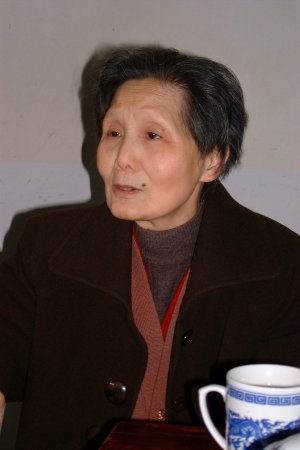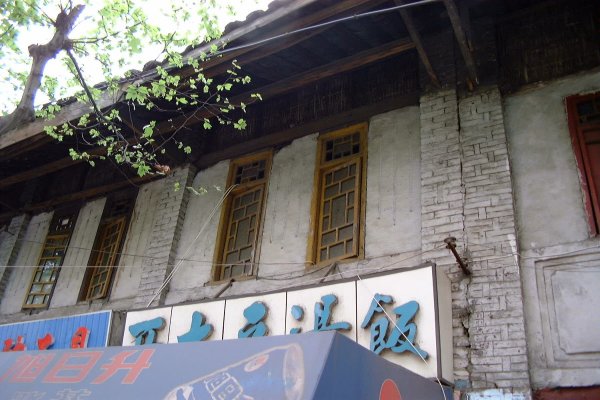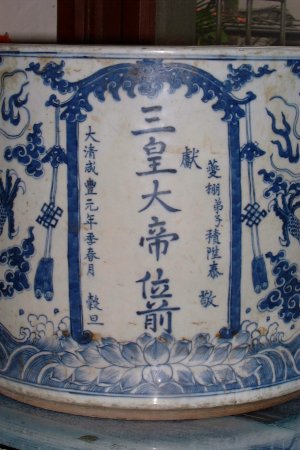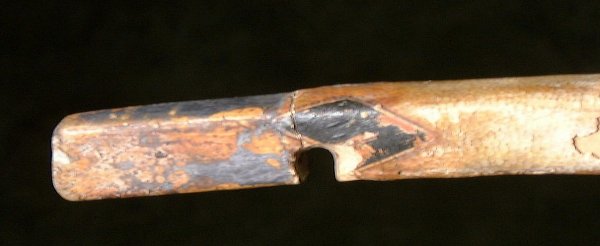

Interview with Ms. Wu Yonghua, 6 April 2000
© Stephen Selby, 2000.
 Wu Yonghua is the daughter of the late Wu Shusen
(1894-1990) of the Chang Xing Bowyers,
Chengdu, Sichuan, China. Wu Shusen (transcribed incorrectly in the English
version of Tan's Report as Wu Shu-lin) was interviewed in depth by the late Prof.
Tan Danjiong (T'an Tan-Chiung) for his "Investigative Report on Bow and
Arrow Manufacture in Chengdu" (Academia Sinica Language and History Review.
Taipei, 1951.) Aged 75, Wu Yonghua is still very fit and her memory is clear.
She participated in the production process in the workshop and sales outlet at
No. 239, Xi Da Jie, Chengdu.
Wu Yonghua is the daughter of the late Wu Shusen
(1894-1990) of the Chang Xing Bowyers,
Chengdu, Sichuan, China. Wu Shusen (transcribed incorrectly in the English
version of Tan's Report as Wu Shu-lin) was interviewed in depth by the late Prof.
Tan Danjiong (T'an Tan-Chiung) for his "Investigative Report on Bow and
Arrow Manufacture in Chengdu" (Academia Sinica Language and History Review.
Taipei, 1951.) Aged 75, Wu Yonghua is still very fit and her memory is clear.
She participated in the production process in the workshop and sales outlet at
No. 239, Xi Da Jie, Chengdu.
 The factory initially occupied two units at number 239. Later, when business
was good, Chang Xing acquired a property over the road at number 228 and moved their retail
outlet there.
The factory initially occupied two units at number 239. Later, when business
was good, Chang Xing acquired a property over the road at number 228 and moved their retail
outlet there.
Both properties are still standing (very unusual in modern Chengdu) and both have been converted to restaurants (no longer under ownership of the Wu family.) The upstairs part that Chang Xing used to rent out to examination candidates still looks much the same as in the 1930s.
 |
 |
Left: Site of the old factory (with two bicycles
passing in front).
Right: upstairs above the shop that used to be rented out to examination
candidates.
ATARN: First, can you tell us about how you started getting involved in the work of the Chang Xing Bowyers? Was it difficult for a woman to become involved?
WU: There was no problem with women working in the shop. It’s true that men did most of the work; but women specialized in preparing the tendons used for reinforcing the bows and in making the strings. I was six or seven years old when I started. (Note. Wu Yonghua would have been seven in 1932.) I remember that the first job I helped with was holding down the bamboo while it was being sawed. Then I used to help carry the bamboo from the yard into the workshop.
Then I started working on the glue. The air bladders were very large: I think they came from sharks. We used to cut them into short lengths and them put them to boil from morning until the evening. We would put it into a big metal pan over a slow fire.
ATARN: Did you add any other ingredients to the glue?
WU: No. After it had boiled all day we just filtered it. We would make a large quantity, then the bowyers just scooped out a bit when they needed it. Before use, the glue was re-heated in a bain-mairie (heated in a container floating in water and not directly over the fire) to make sure that it never reached a temperature too high for the tendons. (Note: recall that the gluing of a whole year's production of bows took place at around the same time of year, so the prepared glue would not have been held for a very long period.)
ATARN: In those days, were there any religious observances connected with the different activities?
WU: Not directly related to specific stages in making the bows; but we did
pray to the ‘Three Emperors’ and ‘Lord Guan’ ![]() four times a year. (Note:
Miraculously, Wu Yonghua had managed to keep the original blue and white
porcelain urn into which the joss-sticks were placed during the rituals. It had
to be painted black and disguised as a rice container to stop it being smashed
by the Red Guards in the Cultural Revolution. Particularly vicious destruction
seems to have been directed at bow-makers during the Cultural Revolution
'Destroy the Four Olds' campaign,
apparently based on a fear that they could arm people to put up resistance. This
was the experience not only in Chengdu, but also in Peking and Chapchal in
Xinjiang.)
four times a year. (Note:
Miraculously, Wu Yonghua had managed to keep the original blue and white
porcelain urn into which the joss-sticks were placed during the rituals. It had
to be painted black and disguised as a rice container to stop it being smashed
by the Red Guards in the Cultural Revolution. Particularly vicious destruction
seems to have been directed at bow-makers during the Cultural Revolution
'Destroy the Four Olds' campaign,
apparently based on a fear that they could arm people to put up resistance. This
was the experience not only in Chengdu, but also in Peking and Chapchal in
Xinjiang.)

ATARN: How was the glue used?
WU: When used, the glue must be below boiling point. It is vital to ensure that no sweat or grease gets into it.
ATARN: Was the same glue used for gluing the horn and for the sinew?
WU: Yes: same glue, same consistency. Before gluing, the surface of the horn had to be scored. We did that by drawing it across the teeth of a saw held in a vise. We used a ‘horse’ to press the horn and the bamboo together tightly before we secured it with a cord.
ATARN: How long was the drying period for the glue?
WU: One year. But that was not just for the purpose of drying the glue. Some bamboo has a natural insect-resistant quality. But you don’t know beforehand which piece will have it and which will not. Country people in Sichuan have a saying, ‘If the bamboo can resist insects for the height of one summer, it will resist them forever.’ So we had to leave the glued staves for the summer and then we would check them at the end of the sixth month of the lunar calendar. Any that had not attracted insects would be used, while any that had been attacked would be rejected.

ATARN: How did you select the bamboo? Did you choose the pieces with the smallest number of joints?
WU: No, it is not the number of joints that counts. You must just ensure that there is not a joint at the centre of the grip, and that there is the same number of joints above and below the grip. Normally, you get two joints above and two below.
ATARN: What about the siyahs?
WU: We used ‘tan’ wood ![]() (sandalwood) for the siyahs and the build-out at the grip.
(sandalwood) for the siyahs and the build-out at the grip.
ATARN: Where the top and bottom sections of horn meet at the grip, did you put in any insert between the horn sections?
WU: No, they could meet up directly. But bows usually failed at the grip. In the times of the military examinations in Peking (Note: Up until 1901), my father and grandfather had to go up to Peking with the candidates to deal with their bows in case there were any failures. They would carry out repairs on the spot.
ATARN: I have heard that an experienced bowyer could make a bow of a certain draw-weight just by weighing the materials in advance. Is that true?
WU: I think that an experienced bowyer could manage that. (Note: this was not a very categorical answer.)
ATARN: Can you tell us a bit about the sinew?
WU: Yes. We used the backstrap sinew of a water buffalo. It had to be taken
from a working ox. It came to us fresh or only partly dried out, and we
immediately removed any meat or fat and then placed them in a damp place on the
ground to keep them damp. (Note: it was clear from the explanation that the
sinew was delivered not to the workshop but to a nearby farm with a threshing
ground.). We used to keep them on the threshing ground with rice husks above and
below. They must not get soaked, nor can they get too dry. Later we would mash
them under a rice-hulling roller ![]() drawn by men or by an ox.
drawn by men or by an ox.
ATARN: I had imagined they were dried first and then crushed with a hammer.
WU: No, that results in a lot of strands of sinew being broken when they would otherwise separate into longer threads. You would end up with too high a proportion of short threads.
After mashing, we still kept them dry by covering them with a damp towel. We would also spit on them. (Note: the use of saliva seems to have been important in processing the sinew: it may have introduced enzymes which helped to break down any fatty material in the sinew.) Then we would sort out the long and the short sections of sinew and set aside enough to make fifty bows (a year’s output). After that, the sinew could be dried out.
We applied the sinew after the horn had been glued onto the bamboo. The long segments went in the centre and the shorter segments towards the tips. The more layers we applied, the heavier the bow would be.
ATARN: Can you tell us about the birch bark?
WU: Yes. I don’t know where it came from. We had to discard the inner and outer layers: only the inside layers were used.
ATARN: Did you put the company name on your bows?
WU: No, we had a special mark. All bows from Chang Xing had a lozenge shaped piece of black birch bark at the corner of the string nock. It was our ‘secret’ trade mark. We did not put any characters on the bows. After the bow was finished, we would varnish it with Tung Oil. They don’t do that in the North.

ATARN: In Peking, they added decoration with peach bark. Did you do that, too?
WU: No, we only used birch bark.
ATARN: What can you tell us about the end of the bowyers' trade in Chengdu?
WU: We were the last. When the anti-Japanese War occurred, we could not continue in business. We all evacuated into the countryside. After the Liberation (1949) there was no longer any market for bows and my father traded as a carpenter. We had a store of bows for some time in a house in the suburbs, but that burned down accidentally and I only have one of the old bows left. (Note: Wu Yonghua's one remaining bow was originally a fine specimen made with white ox-horn (illustrated above). But it is now crumbling to pieces Her niece has a monkey bow for shooting pellets made by Wu Shusen. I have not seen it.)
ATARN: I understand that you took part in an archery competition using a Chinese bow.
WU: Yes, I was trained in traditional archery by my father, and I competed in the First National Sports Championship in the mid-1950s. I took the third place in the women's' championship, and after that I was taken on by the sport institute as an instructor. I taught archery for many years, both with a traditional bow, and then later with a Western bow.
For more material related to this subject, see the history of the Ju Yuan Hao Bowyers in Peking.
Last up-dated: June 11, 2000